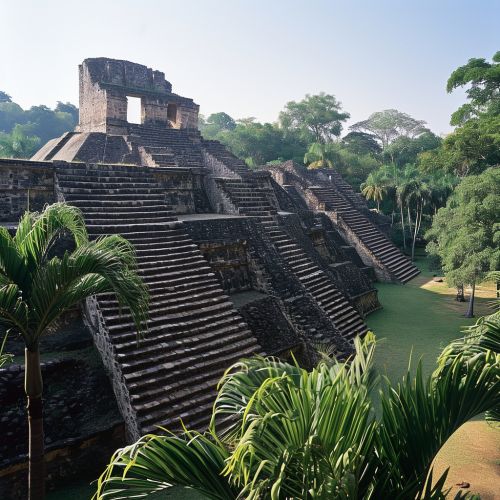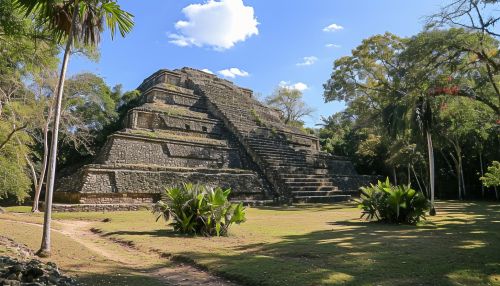Mesoamerican architecture
Overview
Mesoamerican architecture is the set of architectural traditions produced by pre-Columbian cultures and civilizations in Mesoamerica, traditions which are best known in the form of public, ceremonial and urban monumental buildings and structures. The distinctive features of Mesoamerican architecture encompass a wide variety of different regional and period styles, from the earliest simple structures through to the highly elaborate and ornamented buildings of the late pre-Columbian era.
Preclassic Period
The Preclassic period in Mesoamerica is defined as the time before the emergence of the Classic Maya civilization, and is generally divided into the Early Preclassic (2000–1000 BC), Middle Preclassic (1000–400 BC), and Late Preclassic (400 BC–AD 250). During this period, the architectural styles of the Olmec, Zapotec, and Epi-Olmec cultures began to emerge.
Olmec Architecture
The Olmec were the earliest known major civilization in Mesoamerica following a progressive development in Soconusco. They lived in the tropical lowlands of south-central Mexico, in the present-day states of Veracruz and Tabasco. Olmec architecture is characterized by large earthen platforms and structures, often with a central plaza. The most famous of these is the La Venta complex, which includes a large pyramid, several large stone heads, and a complex of smaller structures.
Zapotec Architecture
The Zapotec civilization was an indigenous pre-Columbian civilization that flourished in the Valley of Oaxaca in Mesoamerica. Zapotec architecture is known for its large, rectangular, stepped pyramids, often with a central staircase. The most famous example of Zapotec architecture is the ancient city of Monte Albán, which includes a large central plaza, several large pyramids, and a complex of smaller structures.
Epi-Olmec Architecture
The Epi-Olmec was a culture in the area of Veracruz that succeeded the Olmec culture. Epi-Olmec architecture is characterized by large earthen platforms and structures, similar to those of the Olmec, but with a greater emphasis on monumental sculpture and stelae.
Classic Period
The Classic period in Mesoamerican history is generally defined as the period from AD 250 to 900, during which the Maya civilization reached its peak. During this period, the architectural styles of the Maya, Teotihuacan, and Zapotec cultures continued to develop and evolve.
Maya Architecture
Maya architecture is best known for its stepped pyramids, which were often topped with a temple. These pyramids were built to honor the gods and to provide a place for the Maya to perform their religious rituals. The most famous examples of Maya architecture are the pyramids at the ancient cities of Tikal and Palenque.
Teotihuacan Architecture
The architecture of Teotihuacan, an ancient Mesoamerican city located in a sub-valley of the Valley of Mexico, is characterized by large, rectangular, stepped pyramids, similar to those of the Zapotec, but on a much larger scale. The most famous example of Teotihuacan architecture is the Pyramid of the Sun, one of the largest structures of its type in the Western Hemisphere.
Zapotec Architecture (Classic Period)
During the Classic period, the Zapotec continued to build large, rectangular, stepped pyramids, often with a central staircase. However, their architecture also began to show influences from other Mesoamerican cultures, particularly the Maya.
Postclassic Period
The Postclassic period in Mesoamerican history is generally defined as the period from AD 900 to the arrival of the Spanish in the early 16th century. During this period, the architectural styles of the Toltec, Aztec, and Mixtec cultures emerged.
Toltec Architecture
The Toltec civilization was a pre-Columbian civilization that dominated a state centered in Tula, in the early post-classic period of Mesoamerican chronology. Toltec architecture is characterized by large, rectangular, stepped pyramids, similar to those of the Teotihuacan, but with a greater emphasis on monumental sculpture and relief carvings.
Aztec Architecture
The Aztec civilization was a Mesoamerican culture that flourished in central Mexico in the post-classic period from 1300 to 1521. Aztec architecture is best known for its large, rectangular, stepped pyramids, which were often topped with a temple. The most famous example of Aztec architecture is the Templo Mayor in the Aztec capital of Tenochtitlan.
Mixtec Architecture
The Mixtec were a Mesoamerican culture that flourished in the region of Oaxaca, Puebla and Guerrero in southwestern Mexico. Mixtec architecture is characterized by intricate stone mosaics and relief carvings, which were often used to decorate the facades of buildings.
See Also


